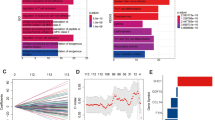Abstract
Purpose
To investigate if macrophage migration inhibitory factor (MIF) affects systemic inflammatory response in patients with non-small cell lung cancer (NSCLC), we studied the relationship between intratumoral MIF expression and serum levels of C-reactive protein (CRP) and interleukin-6 (IL-6).
Methods
mRNAs for MIF and β-actin, and 18S ribosomal RNA derived from tumor-bearing and nontumor-bearing tissues were quantified by a quantitative reverse transcription-polymerase chain reaction in 35 patients with NSCLC. Spearman’s test was used to examine the correlation between the quantities of RNAs and the preoperative serum levels of CRP and IL-6 in the corresponding patients.
Results
The intratumoral level of MIF mRNA was significantly correlated with the serum levels of CRP (ρ = 0.542, P = 0.0016) and IL-6 (ρ = 0.532, P = 0.0173). The level of MIF mRNA in the non-tumor-bearing lung also showed a positive, but relatively weak correlation with the serum CRP level (ρ = 0.418, P = 0.0148).
Conclusion
Macrophage migration inhibitory factor expression in the tumor site may affect the systemic inflammatory response in patients with NSCLC.
Similar content being viewed by others
References
Bernhagen J, Calandra T, Mitchell RA, Martin SB, Tracey KJ, Voelter W, et al. MIF is a pituitary-derived cytokine that potentiates lethal endotoxaemia. Nature 1993;365:756–759.
Calandra T, Bernhagen J, Mitchell RA, Bucala R. The macrophage is an important and previously unrecognized source of macrophage migration inhibitory factor. J Exp Med 1994;179:1895–1902.
Calandra T, Bernhagen J, Metz CN, Spiegel LA, Bacher M, Donnelly T, et al. MIF as a glucocorticoid-induced modulator of cytokine production. Nature 1995;377:68–71.
Nishihira J, Koyama Y, Mizue Y. Identification of macrophage migration inhibitory factor in human leukemia HL-60 cells and its induction by lipopolysaccharide. Biochem Mol Biol Int 1996;40:861–869.
Meyer-Siegler K, Hudson PB. Enhanced expression of macrophage migration inhibitory factor in prostatic adenocarcinoma metastases. Urology 1996;48:448–452.
Bini L, Magi B, Marzocchi B, Arcuri F, Tripodi S, Cintorino M, et al. Protein expression profiles in human breast ductal carcinoma and histologically normal tissue. Electrophoresis 1997;18:2832–2841.
Takahashi N, Nishihira J, Sato Y, Kondo M, Ogawa H, Ohshima T, et al. Involvement of macrophage migration inhibitory factor (MIF) in the mechanism of tumor cell growth. Mol Med 1998; 4:707–714.
Kamimura A, Kamachi M, Nishihira J, Ogura S, Isobe H, Dosaka-Akita H, et al. Intracellular distribution of macrophage migration inhibitory factor predicts the prognosis of patients with adenocarcinoma of the lung. Cancer 2000;89:334–341.
Tomiyasu M, Yoshino I, Suemitsu R, Okamoto T, Sugimachi K. Quantification of macrophage migration inhibitory factor mRNA expression in non-small cell lung cancer tissues and its clinical significance. Clin Cancer Res 2002;8:3755–3760.
Barber MD, Ross JA, Fearson KCH. Changes in nutritional, functional, and inflammatory markers in advanced pancreatic cancer. Nutr Cancer 1999;35:106–110.
Hansen JE, Iverson J, Lihme A, Bog-Hansen TC. Acute phase reaction, heterogeneity, and microheterogeneity of serum proteins as nonspecific tumor markers in lung cancer. Cancer 1987; 60:1630–1635.
Barber MD, Fearson KCH, Ross JA. Relationship of serum levels of interleukin-6, soluble interleukin-6 receptor and tumour necrosis factor receptors to the acute-phase protein response in advanced pancreatic cancer. Clin Sci 1999;96:83–87.
Yoshino I, Maehara Y. Impact of smoking status on biological behavior of lung cancer. Surg Today 2007;37:725–734.
Da Vita F, Orditura M, Auriemma A, Infusino S, Roscigno A, Catalano G. Serum levels of interleukin-6 as a prognostic factor in advanced non-small cell lung cancer. Oncol Rep 1998;5:649–652.
Sakamoto M, Mikasa K, Majima T, Hamada K, Konishi M, Maeda K, et al. Anti-cachectic effect of clarithromycin for patients with unresectable non-small cell lung cancer. Chemotherapy 2001;47:444–451.
Scott HR, McMillan DC, Crilly A, McArdle CS, Milroy R. The relationship between weight loss and interleukin-6 in non-small-cell lung cancer. Br J Cancer 1996;73:1560–1562.
Smith DR, Polverini PJ, Kunkel SL, Orringer MB, Whyte RI, Burdick MD, et al. Inhibition of interleukin 8 attenuates angiogenesis in bronchogenic carcinoma. J Exp Med 1994;179:1409–1415.
Ito N, Nakamra H, Metsugi H, Ohgi S. Dissociation between T helper type 1 and type 2 differentiation and cytokine production in tumor-infiltrating lymphocytes in patients with lung cancer. Surg Today 2001;31:390–394.
Quinn KA, Treston AM, Unsworth EJ, Miller MJ, Vos M, Grimley C, et al. Insulin-like growth factor expression in human cancer cell lines. J Biol Chem 1996;271:11477–11483.
Rusch V, Baselga J, Cordon-Cardo C, Orazem J, Zaman M, Hoda S, et al. Differential expression of the epidermal growth factor receptor and its ligands in primary non-small cell lung cancers and adjacent benign lung. Cancer Res 1993;53:2379–85.
Imoto H, Osaki T, Taga S, Ohgami A, Ichiyoshi Y, Yasumoto K. Vascular endothelial growth factor expression in non-small-cell lung cancer: prognostic significance in squamous cell carcinoma. J Thorac Cardiovasc Surg 1998;115:1007–1014.
Matsuda A, Tagawa Y, Matsuda H, Nishihira J. Expression of macrophage migration inhibitory factor in corneal wound healing in rats. Invest Ophthalmol Vis Sci 1997;38:1555–1562.
Thakur A, Xue ML, Wang W, Lloyd A, Wakefield D, Willcox MDP. Expression of macrophage migration inhibitory factor during Pseudomonas keratitis. Clin Exp Ophthalmol 2001;29:179–182.
Shimizu T, Ohkawara A, Nishihira J, Sakamoto W. Identification of macrophage migration inhibitory factor (MIF) in human skin and its immunohistochemical localization. FEBS Lett 1996;381:199–202.
Author information
Authors and Affiliations
Rights and permissions
About this article
Cite this article
Hamatake, M., Yoshino, I., Tomiyasu, M. et al. Intratumoral expression of macrophage migration inhibitory factor is correlated with serum C-reactive protein and interleukin-6 in patients with non-small cell lung cancer. Surg Today 38, 921–925 (2008). https://doi.org/10.1007/s00595-008-3765-z
Received:
Accepted:
Published:
Issue Date:
DOI: https://doi.org/10.1007/s00595-008-3765-z




